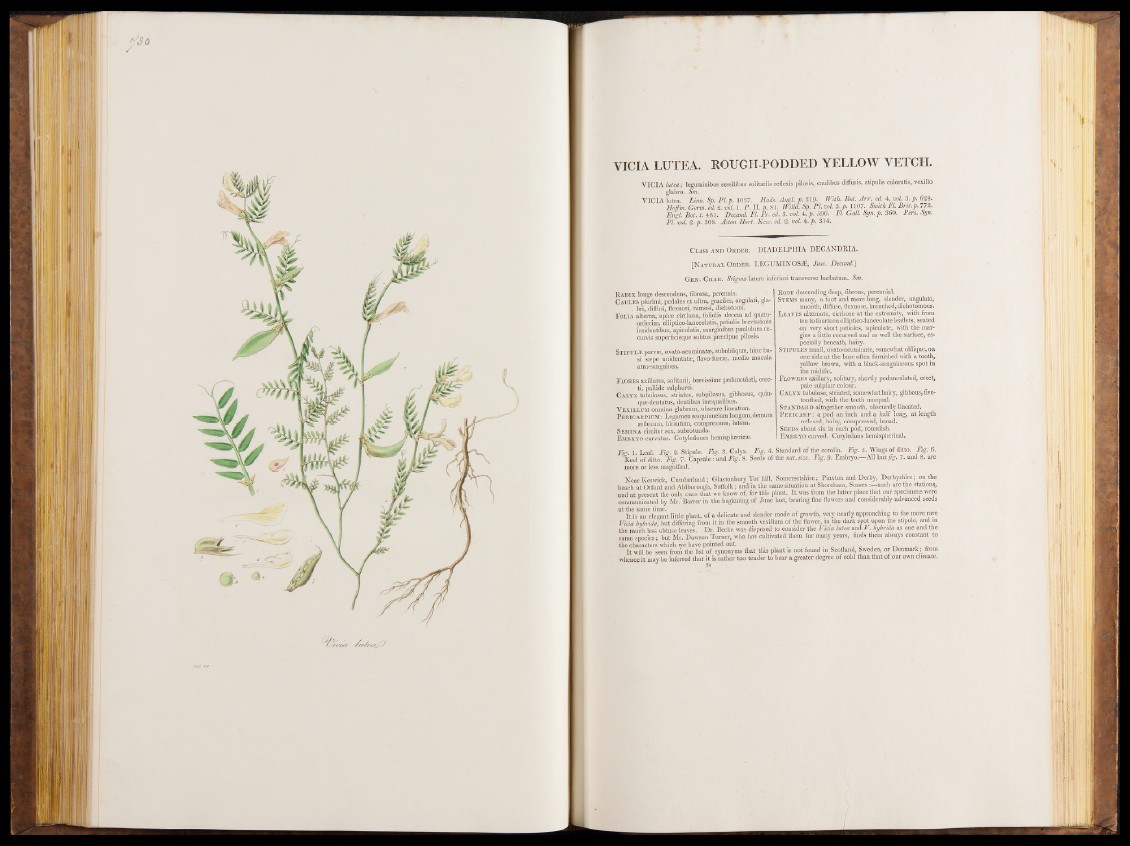
VICIA LUTEA. ROUGH-PODDED YELLOW VETCH.
V IC IA lutea; leguminibus sessilibus solitariis reflexis pilosis, caulibus diffusis, stipulis coloratis, vexillo
glabro. Sm.
V IC IA lutea. Linn. Sp. P L p. 1037. Huds. Angl. p . 319- With. Bet. A r r . ed. 4. ml. 3. p. 624-
H o fm . Germ. ed. 2. vol. 1. P . II. p. 81. Willd. Sp. P L vol. 3. p. 1107. Smith Fl. B n t.p . 772.
Engl. Bot. t. 481. Decand. Fl. Fr. ed. 3. vol. 4. p. 596. Fl. Gall. S y n .p . 360. Pers. Syn.
PI. vol. 2. p. 308. Aiton Hort. Kew. ed. 2. vol. 4. p. 314.
Class and Order. D IA D E L PH IA DECANDRIA.
[N atural Order. LEGUMINOSÆ, Juss. Decand.]
Gen. Char. StigmaMere inferiori transverse barbatum. Sm.
Radix l'Onge descendens, fibrosa, perennis. _ ■'
CaüLES plurimi, pedales et ultra, graciles, angulati, gla-
. bri, difïusi, flexuosi, ràmosi, dichotomi.
Folia alterna, apïce cirrhosa, foliolis decern ad quatu-
ordecim, elliptico-lanceolatis, petiolis brevissimis
insidentibus, apiculatis, marginibus paululum re-
curvis superficieque subtus præcipue pilosis.
Stipulée parvee, ovato-acuminatæ, subobliquse, hinc ba-
si sæpe unidentatæ, flavo-fuscæ, medio macula
atro-sanguinea.
Flores axillares, solitarii, brevissime pedunculati, erec-
ti, pallide sulphurei.
Calyx tubulosus, striatus, subpilosus, gibbosus, quin-
que-dentatus, dentibus inæqualibus.
Vexillum omnino glabrum, obscure lineatum.
Pericarpium : Legumen sesquiunciam longum, demum
. reflexum, hirsutum, compressum, latum.
Semina circiter sex, subrotunda.
Embryo curvatus. Cotyledones hemisphoericæ.
Root descending deep, fibrous, perehnial.
Stems many, a foot and more long, slender, angulate,
smooth, diffuse, flexuose, branched, dichotomous.
Leaves alternate, cirrhose at the extremity, with from
ten to fourteen elliptico-lanceolate leaflets, seated
on very short petioles, apiculate, with the margins
a little recurved and as well the surface, especially
beneath, hairy.
Stipules small, ovato-acuminate, somewhat oblique, on
one side at the base often furnished with a tooth,
yellow brown, with a black-sanguineous spot in
the middle.
Flowers axillary, solitary, shortly pedunculated, erect,
pale sulphur colour.
Calyx tubulose, striated, somewhat hairy, gibbous, fivetoothed,
with the teeth unequal.
Standard altogether smooth, obscurely lineated.
Pericarp : a pod an inch and a half long, at length
reflexed, hairy, compressed, broad.
Seeds about six in each pod, roundish.
I Embryo curved. Cotyledons hemispherical.
Fig 1 Leaf. Fig. 2. Stipule. Fig. 3. Calyx. Fig. 4. Standard of the corolla. Fig. 5. Wings of ditto. Fig. 6.
K eelo f ditto. ÏSg. 7. Capsule: and Fig. S. Seeds of the m t. size. Fig. 9- Embryo.—All but fig. 7. and 8. are
more or less magnified.
Near Keswick, Cumberland; Glastonbury Tor bill, Somersetshire; Pinxton and Derby, Derbyshire; on the
beach at Orford and Aldborough, Suffolk; and in the same situation at Shoreham, S u s s e x s u c h are the stations,
and a t present the only ones that we know of, for this plant. I t was from the latter place that our specimens were
communicated by Mr. Borrer in the beginning of June last, bearing fine flowers and considerably advanced seeds
a t the'same time. , , , . , . . ,,
I t is an elegant little plant, of a delicate and slender mode of growth, very nearly approaching to the more rare
Vicia hybrida but differing from it in the smooth vexillum of the flower, in the dark spot upon the stipule, and in
the much less’obtuse leaves. Dr. Beeke was disposed to consider the Vicia lutea and V hybrida as one and the
same species; but Mr. Dawson Turner, who has cultivated them for many years, finds them always constant to
the characters which we have pointed out. . . _ . . „ , , r
I t will be seen from the list of synonyms that tins plant is not found in Scotland, Sweden, or Denmark; trom
whence it may be inferred that it is rather too tender to bear a greater degree of cold than that of our own climate.
74